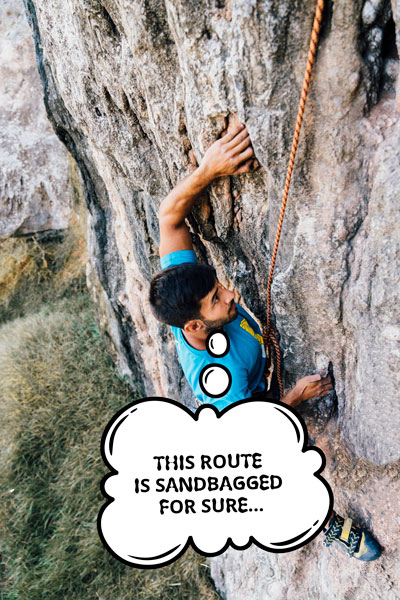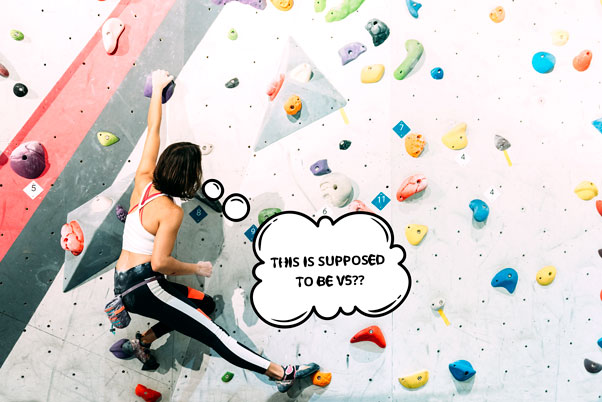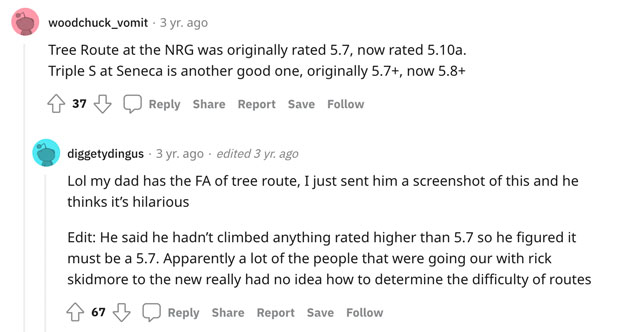Have you ever heard a climber say something along the lines of: ‘the route is sandbagged’ or ‘this bouldering gym sandbags their grades’? Sandbag is a common climbing term so if you are new to climbing, it will help to get to know its full meaning.
So what does Sandbag mean in climbing? Let’s take a look…
What does ‘Sandbag’ mean in climbing/bouldering?
Sandbag is a climbing term used for when a grade is rated way too soft. Meaning the boulder problem or climbing route is much harder than its grade would suggest.
Let’s start with an example in rock climbing.
Say you can easily onsight or flash most 5.9’s (f5c) but you are having a problem sending one particular 5.7 (f5a) route then the route is most definitely sandbagged.

“That 5.10a is totally sandbagged, dude.”
Or here’s a bouldering example.
You can easily flash V5s in your local indoor gym as well as most other commercial bouldering gyms. But on a trip to Europe, you try out a small niche climbing gym only to realize you can’t even send a 6a (V3) at this gym.

“that bouldering gym sandbags their grades to resemble outdoor grades.”
In this case, the gym is likely trying to match indoor bouldering grades with outdoor ones. This is a practice that is rare and only done at some hardcore bouldering gyms as most gyms want to cater to beginners and therefore grade really soft, especially the beginner grades to allow for easy progression.
A sandbag is also sometimes used by climbers to prank their buddies. “Yeah, you can do that route, it’s easy! It’s only graded 5.7. You flash those in your sleep!”
Other Climbing Terms Explained
What is the origin of the word Sandbag in climbing?
The term ‘sandbag’ in climbing was popularized by climbers who would imagine climbing a route with a sandbag attached to their harness. There is very little to no information that can be found about when the term ‘sandbag’ or ‘sandbagging’ was first adopted in climbing. All we know is that it one of the most commonly used terms in modern day climbing.
Why do Sandbags exist?
Sandbagged routes and boulder problems exist in climbing for a number of reasons:
- Climbing grading are subjective
- Experienced climbers often grade routes poorly
- Route setters are bad at estimating lower grades
- Classic routes are graded much harder than now
- You are using the wrong beta
Climbing Grades are Subjective
Sandbags primarily exist due to the subjective nature of grading. What one climbers might consider a 5.9, another climber might grade at 5.8 or even lower. Every climber has a different standard for grading. Some grade really soft, while others grade really hard.
Experienced Climbers often Grade Routes Poorly
Some climbers are so experienced they can’t tell the difference between routes graded 5.7 – 5.8 – 5.9 and so forth. As a result, they might give a very low grade to a route that seems far too easy for their experience level.
This isn’t necessarily done for reasons one might suspect (e.g. stroking their ego) but most likely done unknowingly. They simply found the route so easy, it couldn’t possible have been a harder grade in their mind.

The screenshot above is a funny interaction I found on a Reddit post. One guy points out that the Tree Route at NRG is ‘sandbagged’ and was originally rated 5.7 and is now rated 5.10a. Only for some guy to comment that his dad had the First Ascent of said route and rated it 5.7 because he hadn’t climbed anything higher than 5.7 before.
Route Setters are bad at estimating lower grades
While sandbagging is most commonly used in outdoor climbing, it can occur in indoor climbing and bouldering gyms as well.
This ties in with our previous argument that experienced climbers are bad at estimating lower grades.
The route setters at your gym are experienced climbers who might not have a great grasp of what lower grades (e.g. V0 – V3) should look like in a bouldering gym. Or what 5.8 – 5.10 routes should look like in a climbing gym.
This might result in some indoor grades feeling like sandbags when compared to other grades at the same gym.
For example, at my first bouldering gym, the beginner boulders graded V0 – V3 (it was actually font 4 – 6a but let’s stick to V-scale for the sake of this article) were always a complete throw.
In many cases, the V0 was harder than the V1 or even the V2 next to it. I had V2 problems that seemed impossible and V3s that seemed way too easy. At this gym, you really had to ignore the color-coding completely and just read the problems and go for it.
That’s how I send my first V3. It looked easy (and it was). I probably didn’t deserve it at the time, but that’s beside the point.
What I’m saying here is that to experienced climbers lower problems/routes are simply so easy they can’t stick an accurate grade to it.
If the problem had a single crimp, it was automatically graded V3 and above at my gym. Regardless of how easy the problem really was.
Classic routes are graded much harder
Modern-day climbing is very different from what the climbing that was done in the past. If you were to attempt old-school routes based on difficulty using their original grade, they would feel extremely sandbagged.
This is because grading has gotten extremely soft compared to how it used to be. This is immediately clear to climbers who visit old school crags such as the Gunks or Yosemite.
You are using the wrong beta
You can’t always blame the setter or the first ascensionist for a sandbag. Sometimes (believe it or not), the problem lies with you and not the route.
This is what happens when you attempt a route or boulder problem with the wrong beta in mind. Maybe you are missing a particular foothold and creating an unnecessary crux that might make the route feel like a sandbag?
If you are experiencing a sandbag at a climbing gym, always ask another climber for a beta before you go ahead and give it the old ‘sandbag’ excuse 😉.
Is Sandbagging dangerous?
Sandbagging can be dangerous as it could lead climbers to attempt a route that is way above their skill level.
For example, if a beginner sport climber would attempt similar grades to what they are used to on multi-pitch routes in the Gunks or Yosemite, that could potentially be very dangerous.
However, in most cases, climbers aren’t going to go on routes without doing proper research (at least I hope not). So I can’t imagine this is too common in real scenarios.
Does Sandbagging make you a better climber?
In a way, sandbagged routes can make you a better climber. This is because these routes push you to try something out of your comfort zone, which could end up being a positive thing.
For example, here is what Cedar Wright said about the Sandbagged Shark’s fin in Utah in a climbing mag article:
That’s the value of a good sandbag; it pushes us out of our comfort zones and into adventure.
Cedar Wright | The Wright Stuff: The Art of the Sandbag – Climbing Mag
Sometimes we underestimate our capabilities. Or fear is holding us back. A good sandbag can result in us pushing ourselves and pushing our limits as a climber.
Other Climbing Terms Explained
More articles like this
- Indoor Bouldering Basics: intro to gym climbing
- Tips for short climbers
- Complete Guide to Bouldering Grades (& conversions)
- How to start and finish a boulder problem
- Can I get abs from climbing?
- Bouldering vs rock climbing
- How often you should go bouldering per week
- Why bouldering is a good full-body workout
- Climbing 101: what is cutting feet?
- How long does it take to progress in bouldering?
- How much does it cost to start bouldering?
- What to wear indoor bouldering
- How much of a bouldering wall can you use?
- Should climbing shoes hurt?
- How many climbing shoes do you really need?
- Yoga for climbers
- Core workout for climbers